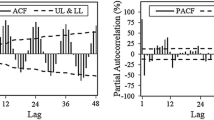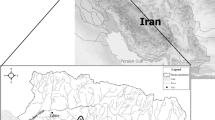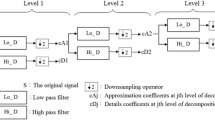Abstract
Forecasting reservoir inflow is one of the most important components of water resources and hydroelectric systems operation management. Seasonal autoregressive integrated moving average (SARIMA) models have been frequently used for predicting river flow. SARIMA models are linear and do not consider the random component of statistical data. To overcome this shortcoming, monthly inflow is predicted in this study based on a combination of seasonal autoregressive integrated moving average (SARIMA) and gene expression programming (GEP) models, which is a new hybrid method (SARIMA–GEP). To this end, a four-step process is employed. First, the monthly inflow datasets are pre-processed. Second, the datasets are modelled linearly with SARIMA and in the third stage, the non-linearity of residual series caused by linear modelling is evaluated. After confirming the non-linearity, the residuals are modelled in the fourth step using a gene expression programming (GEP) method. The proposed hybrid model is employed to predict the monthly inflow to the Jamishan Dam in west Iran. Thirty years’ worth of site measurements of monthly reservoir dam inflow with extreme seasonal variations are used. The results of this hybrid model (SARIMA–GEP) are compared with SARIMA, GEP, artificial neural network (ANN) and SARIMA–ANN models. The results indicate that the SARIMA–GEP model (R 2=78.8, VAF =78.8, RMSE =0.89, MAPE =43.4, CRM =0.053) outperforms SARIMA and GEP and SARIMA–ANN (R 2=68.3, VAF =66.4, RMSE =1.12, MAPE =56.6, CRM =0.032) displays better performance than the SARIMA and ANN models. A comparison of the two hybrid models indicates the superiority of SARIMA–GEP over the SARIMA–ANN model.









Similar content being viewed by others
References
Abebe A and Foerch G 2008 Stochastic simulation of the severity of hydrological drought; Water Environ. J. 22 2–10.
Aksoy H, Unal N, Eris E and Yuce M 2013 Stochastic modeling of Lake Van water level time series with jumps and multiple trends; Hydrol. Earth Syst. Sci. 17 2297–2303.
Alavi A H and Gandomi A H 2011 A robust data mining approach for formulation of geotechnical engineering systems; Eng. Comput. 28 242–274.
Ali S M 2013 Time series analysis of Baghdad rainfall using ARIMA method; Iraqi J. Sci. 54 1136–1142.
Box G E and Pierce D A 1970 Distribution of residual autocorrelations in autoregressive-integrated moving average time series models; J. Am. Statist. Assoc. 65 1509–1526.
Chebaane M, Salas J D and Boes D C 1995 Product periodic autoregressive processes for modeling intermittent monthly streamflows; Water. Resour. Res. 31 1513–1518.
Cryer J and Chen K 2008 Time Series Analysis with Applications in R; Springer Texts in Statistics, New York, USA.
Dagum E B, Lothian J R and Morry M 1975 A test of independence of the residuals based on the cumulative periodogram; Seasonal Adjustment Methods Unit, Statistics Canada.
Ebtehaj I and Bonakdari H 2013 Evaluation of sediment transport in sewer using artificial neural network; Eng. Appl. Comput. Fluid Mech. 7 382–392.
Ebtehaj I, Bonakdari H, Zaji A H, Azimi H and Sharifi A 2015 Gene expression programming to predict the discharge coefficient in rectangular side weirs; Appl. Soft. Comput. 35 618–628.
Faruk D Ö 2010 A hybrid neural network and ARIMA model for water quality time series prediction; Eng. Appl. Artif. Intel. 23 586–594.
Ferreira C 2001 Algorithm for solving gene expression programming: A new adaptive problems; Complex Systems 13 87–129.
Ferreira C 2006 Gene Expression Programming: Mathematical modeling by an artificial intelligence; Springer Berlin Heidelberg, New York, USA.
Filho J, Affonso C M and Oliveira R C 2014 Energy price forecasting in the North Brazilian market using NN-ARIMA model and explanatory variables; In: Proc. Comput. Intel. Eng. Solut. (CIES), Orlando, Florida, USA, 9–12 December.
Firat M 2008 Comparison of artificial intelligence techniques for river flow forecasting; Hydrol. Earth. Syst. Sci. 12 123–139.
He Z, Wen X, Liu H and Du J 2014 A comparative study of artificial neural network, adaptive neuro fuzzy inference system and support vector machine for forecasting river flow in the semiarid mountain region; J. Hydrol. 509 379–386.
Hirsch R M and Slack J R 1984 A nonparametric trend test for seasonal data with serial dependence; Water Resour. Res. 20 727–732.
Kashyap R L and Rao A R 1976 Dynamic stochastic models from empirical data; Mathematics in Science and Engineering, New York, USA.
Khoshbin F, Bonakdari H, Ashraf Talesh S H, Ebtehaj I, Zaji A H and Azimi H 2016 Adaptive neuro-fuzzy inference system multi-objective optimization using the genetic algorithm/singular value decomposition method for modelling the discharge coefficient in rectangular sharp-crested side weirs; Eng. Optimiz. 48 933–948.
Kilinç I and Cigizoglu K 2005 Reservoir management using artificial neural networks; In Proc. 14th. Reg. Director. DSI (State Hydraulic Works), Istanbul, Turkey.
Kisi Ö 2004 River flow modeling using artificial neural networks; J. Hydrol. Eng. 9 60–63.
Kisi Ö and Cigizoglu H K 2007 Comparison of different ANN techniques in river flow prediction; Civil Eng. Environ. Syst. 24 211–231.
Kisi O, Dailr A H, Cimen M and Shiri J 2012a Suspended sediment modeling using genetic programming and soft computing techniques; J. Hydrol. 450 48–58.
Kisi O, Shiri J and Nikoofar B 2012b Forecasting daily lake levels using artificial intelligence approaches; Comput. Geosci. 41 169–180.
Kothari M and Gharde K 2015 Application of ANN and fuzzy logic algorithms for streamflow modelling of Savitri catchment; J. Earth Syst. Sci. 124 933–943.
Koutroumanidis T, Ioannou K and Arabatzis G 2009 Predicting fuelwood prices in Greece with the use of ARIMA models, artificial neural networks and a hybrid ARIMA–ANN model; Energ. Policy 37 3627–3634.
Koza J R 1992 Genetic programming : On the programming of computers by means of natural selection; MIT press, London, England.
Levenberg K 1944 A method for the solution of certain non–linear problems in least squares; Quart. Appl. Math. 2 (2) 164–168.
Liu H, H-q T. and Li Y -f 2012 Comparison of two new ARIMA–ANN and ARIMA–Kalman hybrid methods for wind speed prediction; Appl. Energ. 98 415– 424.
Lohani A, Kumar R and Singh R 2012 Hydrological time series modeling: A comparison between adaptive neuro-fuzzy, neural network and autoregressive techniques; J. Hydrol. 442 23–35.
Makridakis S, Wheelwright S C and Hyndman R J 2008 Forecasting methods and applications; John Wiley & Sons, Hoboken, New Jersey, USA.
Mann H B and Whitney D R 1947 On a test of whether one of two random variables is stochastically larger than the other; Ann. Math. Stat., pp. 50–60.
Marco J B, Harboe R and Salas J D 2012 Stochastic hydrology and its use in water resources systems simulation and optimization; Springer Science & Business Media, B V, Peniscola, Spain.
Moeeni H and Bonakdari H 2016 Forecasting monthly inflow with extreme seasonal variation using the hybrid SARIMA–ANN model; Stoch. Env. Res. Risk. A, http://dx.doi.org/10.1007/s00477--016--1273-z.
Mohammadi K, Eslami H and Dardashti S D 2005 Comparison of regression, ARIMA and ANN models for reservoir inflow forecasting using snowmelt equivalent (a case study of Karaj); J. Agric. Sci. Technol. 7 17–30.
Mohan S and Vedula S 1995 Multiplicative seasonal ARIMA model for longterm forecasting of inflows; Water Resour. Manag. 9 115–126.
Nourani V, Kisi Ö and Komasi M 2011 Two hybrid artificial intelligence approaches for modeling rainfall–runoff process; J. Hydrol. 402 41–59.
Salas J, Delleur J, Yevjevich V and Lane W 1988 Applied Modeling of Hydrologic Time Series; Water Resources Publications, Colorado, USA.
Sharma N, Zakaullah M, Tiwari H and Kumar D 2015 Runoff and sediment yield modeling using ANN and support vector machines: A case study from Nepal watershed; Model Earth Syst. Environ. 1 1–8.
Valipour M 2015 Long-term runoff study using SARIMA and ARIMA models in the United States; Meteorol. Appl. 22 592–598.
Valipour M, Banihabib M E and Behbahani S M R 2013 Comparison of the ARMA, ARIMA, and the autoregressive artificial neural network models in forecasting the monthly inflow of Dez dam reservoir; J. Hydrol. 476 433–441.
Wang W, Van Gelder P and Vrijling J 2005 Long-memory in streamflow processes of the Yellow river; In: Proc. IWA Int. Conf. Water Economics Statistics and Finance Rethymno, Greece, 8–10 July, 2005.
Wang W -C, Chau K -W, Cheng C -T and Qiu L 2009 A comparison of performance of several artificial intelligence methods for forecasting monthly discharge time series ; J. Hydrol. 374 294–306.
Yurekli K and Kurunc A 2005 Performances of stochastic approaches in generating low streamflow data for drought analysis; J. Spat. Hydrol. 5.
Yurekli K, Kurunc A and Ozturk F 2005 Application of linear stochastic models to monthly flow data of Kelkit Stream; Ecol. Model. 183 67–75.
Zhang G P 2003 Time series forecasting using a hybrid ARIMA and neural network model; Neurocomputing 50 159–175.
Acknowledgement
The authors would like to express their appreciation to Ms. Maya Binder for final editing of the English text.
Author information
Authors and Affiliations
Corresponding author
Additional information
Corresponding editor: Rajib Maity
Rights and permissions
About this article
Cite this article
Moeeni, H., Bonakdari, H. & Ebtehaj, I. Monthly reservoir inflow forecasting using a new hybrid SARIMA genetic programming approach. J Earth Syst Sci 126, 18 (2017). https://doi.org/10.1007/s12040-017-0798-y
Received:
Revised:
Accepted:
Published:
DOI: https://doi.org/10.1007/s12040-017-0798-y




